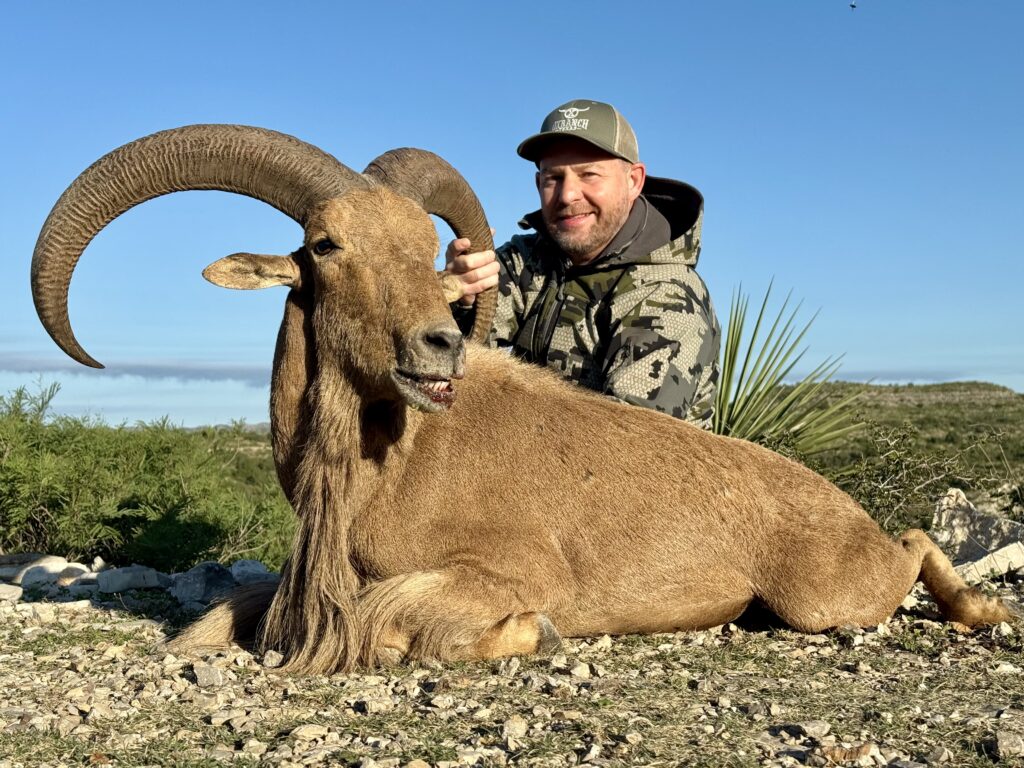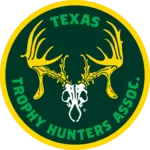Hunting aoudad in Uvalde, Texas
By Dustin Catrett
“Up on that hill,” said my guide Kris, slamming the brakes on the Jeep. After riding for several hours with a few brief encounters, I was relieved to see a large herd of tan aoudad running up the hillside. With his eyes pressed into his binocular, he advised me to quickly slide my gun barrel out the front opening of the buggy’s windshield. Within a hazy wave of the scope’s reticle, a bramble of sweeping horns slowly came into focus as I twisted the dial for a closer look.
Heavy based horns, tight curves, some wider, some longer than others made choosing a trophy from this group of 30 or more aoudad a challenge. Moments before, they were casually browsing at a much lower elevation until they spotted our Jeep dusting along the ranch road, causing them to bolt for higher ground. Watching in amazement as they ascended the steep cliff face as if it were a staircase, it became clear that if they decided to top the hill, they would more than likely be gone.
Top of the hill
However, after several minutes they eventually began to settle down along a thicket of brush, topped with a single yucca plant protruding from its center near the top of the hill. Perhaps the higher elevation gave them comfort as one by one they began to lie down, leaving only the tops of their horns and a few patches of brown fur and chaps in the opening within the brush. Picking the largest trophy to shoot became the next challenge, as a large mature aoudad can appear strikingly like one another to the untrained eye. Luckily my guide for this hunt was Kris Helms, manager of the Ox Ranch, who had an exceptional eye for spotting trophy aoudad.
“The older rams everyone likes are generally broomed off at the tips of their horns as they age which can lose a little length, but you still get that old, mature look,” he explained. “Whereas there are some studs in there that may be a few years younger that are longer in length. It just depends on what you like. On average aoudad generally take about eight years to reach maturity before they hit that magical 30-inch mark everyone wants. The best one for length though is the one standing to the left of that yucca plant where you can just see the top of its horns.”
Getting ready
After a few minutes of glassing the herd, several of the larger rams began to stand. One being the long, heavy-horned ram to the left of the yucca Kris had spotted. “From what I’ve seen, the more dominant rams are either the leaders of the group who stay out in front when they are moving, or they will be the last one in the back,” Kris said. With the turret set to two, the 200-plus-yard shot would be vertically uphill.
“He’s starting to move to the left a little more, not sure if you can see him through your scope yet,” Kris whispered, as all the aoudad were beginning to stand to follow the lead of the ram we were after. “Patience, grasshoppa,” Kris quipped, detecting my breathing was beginning to pick up as the full sight of these massive rams was increasing my heart rate. Now with only two smaller aoudad blocking my view of the big ram, I clicked off the safety and continued holding the crosshairs on where his shoulder should appear, should the rams move and provide an opening.
Moment of truth
After a few more seconds, our ram stepped forward past the other two and turned broadside, offering me a momentary shot. “Take him if you’re good,” Kris said, trading out his binocular for a video camera. Slowly I squeezed the trigger while exhaling. The suppressed 7PRC whispered a split second before the wallop of the ram’s shoulder left a puff of dust, leaving no doubt it was a good hit. “You smoked him!” Kris said as the herd exploded from the brush and took off over the top of the hill.
After a short hike uphill, we began to search for the aoudad, although no blood could be found anywhere. Several minutes later, Kris discovered the ram expired within a patch of prickly pear. “These things tend to suck bullets up,” he remarked, noting how this wasn’t the first time an aoudad ram had run with no trace of blood. Peculiarly the aoudad had no exit wound, and if you didn’t know any better, it appeared as if it hadn’t been shot at all with only a tiny entrance hole detectable by an 1/8th burr under its shoulder.
Success
“That’s a rock donkey for sure,” Kris said, gripping the base of its horns that were almost touching with only a small indication that hair used to grow in between them. The gorgeous ram was huge and rugged, just as I had imagined it would be like putting my hands on the ram for the first time. Its heavy horns would eventually tape out at 13 inches in circumference at the base and just under 32 inches in length once we arrived back at the skinning facility. The mountainous terrain of the ranch delivered exactly what I had always wanted to hunt in the hills of Texas: an old trophy aoudad ram.



